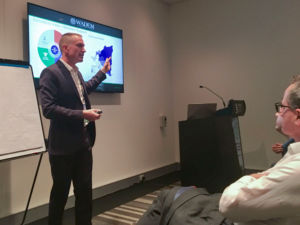Dr. Benjamin Ryan, DKI APCSS, and Dr. Joseph Green, Pacific Disaster Center (PDC), proposed a systematic methodology to rank needs of people with life threatening conditions and chronic diseases before, during and after a disaster at the World Association for Disaster and Emergency Medicine (WADEM) Congress in Brisbane, Australia, on May 8, 2019.

Dr. Ryan, DKI APCSS
Dr. Ryan discussed how disasters can damage the essential social protections and public health infrastructure required for vulnerable populations. This contributes to indirect mortality and morbidity as high as 70–90%, primarily due to an exacerbation of life-threatening conditions and chronic diseases. The people at greatest risk are those with underlying cardiovascular and respiratory diseases, unstable diabetes, renal diseases, mental health conditions and those undergoing cancer treatment. Despite this, the traditional health focus of humanitarian assistance and disaster relief (HADR) systems has been on communicable diseases. There is now an urgent need to expand HADR efforts in health to include people with chronic diseases.

Dr. Green, Pacific Disaster Center
Dr. Green proposed that a repeatable and measurable methodology would help address this challenge by allowing the needs of people with life-threatening and chronic diseases to be systematically ranked and prioritized before, during and after a disaster. He discussed how a methodology is already in-place for this to occur, PDC’s Risk and Vulnerability Assessment (RVA) linked with DisasterAWARE™ (All-hazard Warnings, Analysis, and Risk Evaluation). The combination of RVA and DisasterAWARE™ has been successfully applied to the assessment and prioritization of disaster risk and humanitarian assistance needs in Southeast Asia (ASEAN, Viet Nam), Central America (Guatemala, El Salvador, Honduras, Nicaragua), South America (Peru), and the Caribbean (Jamaica, Dominican Republic).
An expansion of the use of PDC’s RVA and DisasterAWARE™ to rank and prioritize needs at national and sub-national levels is a sustainable approach to addressing this challenge. According to Dr. Ryan and Dr. Green this expansion would include using indicators related to chronic disease burden, risk factors (for example, poverty and tobacco consumption) and health care capacity. Implementation of this would support HADR systems at local, national and regional levels by providing reliable information to accurately develop plans and strategies for reducing indirect mortality and morbidity before, during and after a disaster.
The views expressed in the article are those of Dr. Ryan and Dr. Green and do not necessarily reflect those of DKI APCSS, the Department of Defense, or the U.S. Government.










Leave A Comment